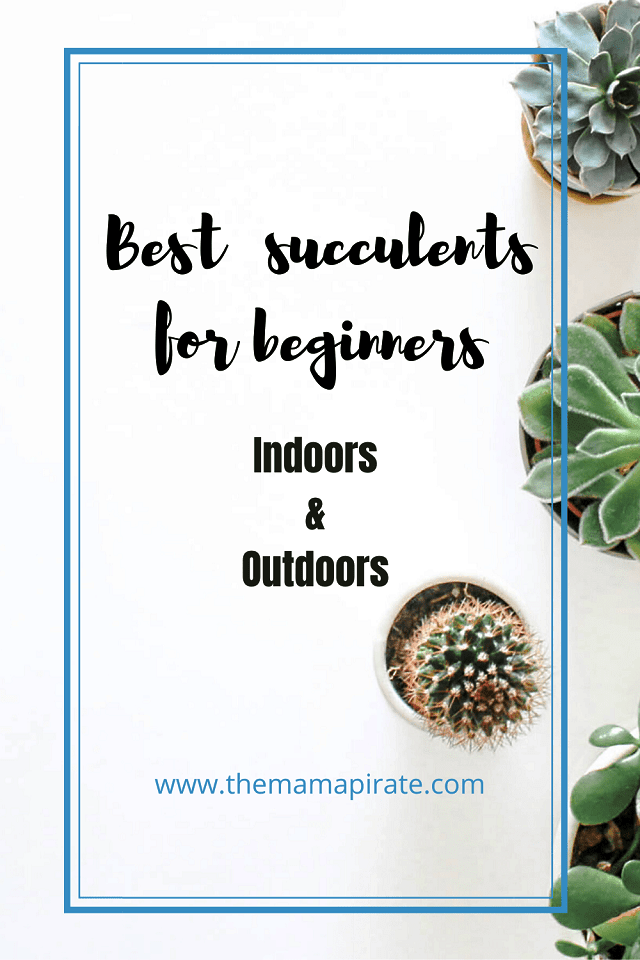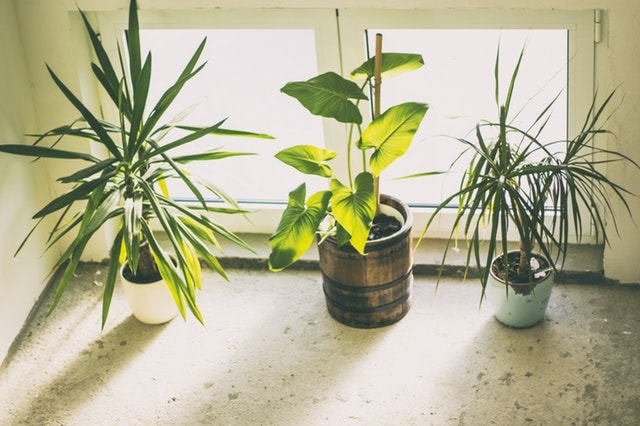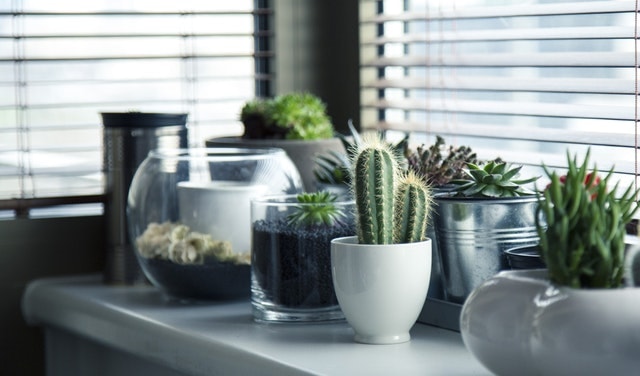Last Updated on 3 years ago by Namrata
Are you excited to grow your first succulent indoors? Some succulents are easy to grow if you know how to care for them. We have compiled Best Indoor and Outdoor Succulents for beginners that need very less care after you planted. You need to be careful only at the beginning.
The best about succulents is that they are best for beginners. They require very little vigilance. They can survive in almost any climate. They look beautiful and bring a modern feel to your space. They don’t require any kind of special arrangement or expertise. Also, no matter if you have a busy schedule, you don’t need to have a perfect water schedule for them.
Some of the basic needs of these succulents are:
- Fast draining succulent soil.
- Enough light.
- Water only when soil is dry.
- Not too cold climate.
- Protection from hard frost.
Succulents for Beginners that Need No Care at All
So let’s begin the list:
1. Aloe vera

It’s one of the most common and cherished succulents available out there. The clear gel inside its toothed leaves has many medicinal uses. You can use it as a beauty treatment for the skin. Gel act as medicine for burns, rashes, stomach ailments, and much more. Aloe vera will grow happily both indoors and outdoors.
You should provide full sun to part shade outdoors, or bright light for indoors. Aloe vera requires protection from freezing by overwintering indoors. This easy-growing ground succulent reaches up to 3 feet tall, expanding by offsets. You can Increase your Aloe vera collection by dividing the offsets from the mother plant and planting them.
2. Crassula Ovata- Jade
Also known as the Jade plant. It’s one of the most popular succulents all around the globe. The dark green, oval leaves succulents are born on semi-woody stems. This easy succulent for beginners will thrive in full shade to full sun, no matter indoor or outdoor.
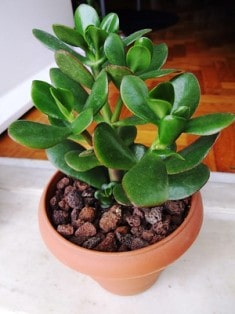
In enough light, the leaf margins turn red in color, and in spring it blooms, forming clusters of bright, beautiful flowers. These flowers attract honeybees and butterflies. These succulents grow up to 5-feet tall to form a well-branched, awesome shrub. In cold winter weather, it is preferred to bring your jade plant indoors until spring shows again.
Crassula ovata needs protection from freezing temperature, and water only when it’s dry. You can easily propagate either from leaf or from stem cuttings. This succulent will be the ideal selection for your fairy garden.
3. Portulacaria afra
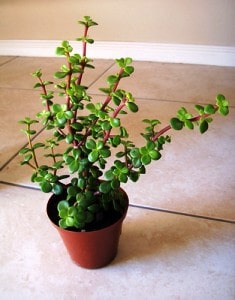
Popularly known as an elephant food plant. These are found in huge quantities across Africa, where elephants eat, break and crush these plants. Which is the reason they grow more and more? Their straight burgundy succulent stems are covered with small green leaves. These stems can grow up to 30 ft tall, the condition is to grow in the ground in a mild winter climate.
You need to grow Portulacaria afra in full sun to semi-shade, in the ground, or in containers. A wonderful texture is added to mixed succulent containers by the vertical lines. You need to protect these succulents from freezing by overwintering indoors. This is an easy and perfect succulent for beginners, as it’s best for learning how to prune. You can propagate easily by stem cuttings or even individual leaves.
4. Aeonium Kiwi
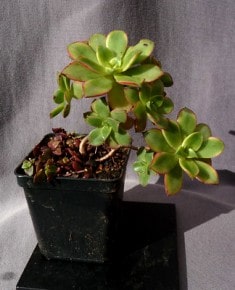
The beautiful Aeonium Kiwi is an especially appealing and easy succulent for beginners to grow at home. Its flower-like foliage clusters make it look lovely in any surroundings. The curve and woody stem branch end in an attractive rosette. You need to grow these in full sun to shade, but I recommend providing shade when temps are routinely high i.e 80s F (26+ Celcius) or even above.
In full sun, Aeonium Kiwi gets yellow and pink flashy color to its leaves that further increase the floral appeal and make it more beautiful. To propagate you just need to cut the stem and plant it elsewhere. If you live in a cold region then place them indoors. You should continue watering only when you see signs of new growth.
5. Graptopetalum paraguayense
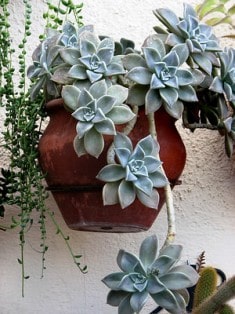
This graceful succulent is also known as the ghost plant. It is an easy and fast-growing succulent for beginners to grow at home. Its white leaves with silvery finish develop an opalescent look with blue and pink tones. This feature gives it a unique name that is the mother of pearl plants.
A flower-like rosette is formed by leaves at the end of semi-woody, curling stems. These plants grow up to 1 foot tall and may trail 3 feet long. You must grow them in full sun to partial shade and protect them from freezing. Its beautiful display is beckoning bees and butterflies in spring. You can propagate ghost plants by stem cuttings or even leaf propagation.
6. Faucaria tigrina ‘Tiger Jaws’
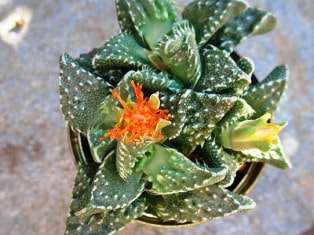
The reason for the name ‘Tiger Jaws’ is the fierce-looking soft and flexible “teeth” of Faucaria tigrina. The leaves are triangular in shape and are chubby and wedged. It is covered by bright yellow blooms that look like fringed daisies for almost months.
To propagate you need to cut the stems and plant them. You need to grow these Tiger jaws in the partial shade outdoors or in bright light indoors. This is an easy and fast-growing succulent for beginners. This indoor succulent is sensitive to cold.
7. Sedum Autumn Joy
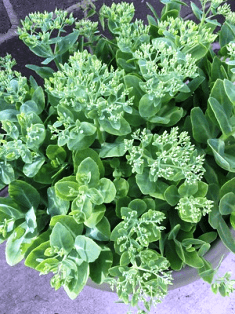
Sedum Autumn Joy is a beautiful border plant. It forms graceful mounds of foliage that can be 1 foot tall and wide. In summer, the succulent is covered with tight buds which later explode into bright pink blooms that last all autumn making it look beautiful. These invite a lot of butterflies and bees all around them. You can propagate them through the stem cutting method. You can grow this easy succulent for beginners in full sun to light shade.
8. Echeveria Perle von Nurnberg
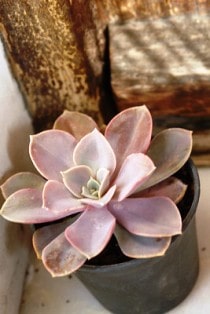
Echeveria Perle von Nurnberg is a beautiful rosette succulent available in lavender-pink color. It is quite famous for its flower-like appearance and all echeveria succulents are easy to grow especially for beginners. It grows best outdoors in full sun to light shade as its coloring gets deep and intensified while kept in full sun.
They may grow to 6-inches in size. One can easily propagate using the stem cutting method or even individual leaves. The soft sheen of epicuticular wax is available on the leaves of PVN. In summer Arching stems of pink and yellow blooms are highly attractive to hummingbirds.
Best Indoor Succulents for Beginners
Indoor plants are capable of making any room look much better. Who would not like a splatter of healthy greenery in their room which can make them feel instantly welcoming and fresh? These Best indoor succulents purify the air in your room making your place healthier. So I am here with a list of Unique looking succulents for your room, which are low-maintenance and easy to grow.
1. Christmas Cactus
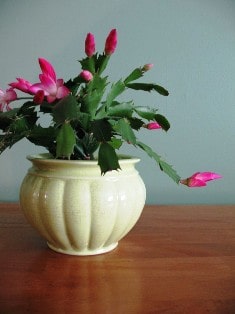
Also known as crab claw cactus, because unlike other cactuses available out there, the Christmas cactus doesn’t have sharp spines. Once it starts growing, its flat, fleshy, full of gel stems can reach about a foot in length and even drape over. This cactus requires moisture to grow well, so you will need to water the plants whenever you find that the topsoil is dry enough.
It is preferred to keep it in bright light near some shade, they bloom mostly during winters. They may even bud earlier and bloom flowers of yellow color.
2. Burro’s Tail
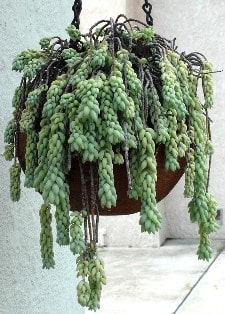
Burro’s tail or even known as donkey tail is a trailing succulent. It looks great in hanging baskets or even containers kept near the window, which will allow the succulent to drape over. They have the property of growing up to three feet long and are packed with grey-green leaves. The leaves are about the size and shape of a plump grain of rice.
It’s rare for a burro’s tail to gloom but still, you might witness pink or red flowers at the end of the stems in summer. It is preferred to keep them in bright light for best performance. Watering them regularly does not require during winters when they aren’t actively growing.
3. Kalanchoe tomentosa- Panda Plant
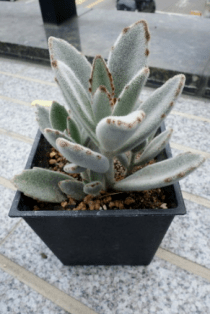
Panda plant falls under the category of Kalanchoe plants. They have fuzzy, grey-green-colored leaves that are covered with soft, silvery hairs. They tip down with brown or rust-color spots. They grow about two feet tall as a houseplant, but the growing process is very slow.
You need to provide the plants with bright light under shade. Let the soil dry between watering intervals. You need to take care that when watering them, do not overwater leaves as they may rot.
4. Ponytail Palm
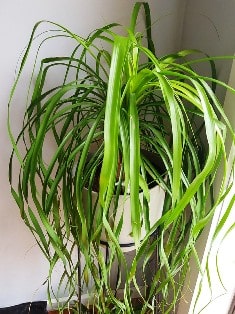
Don’t worry they are not actually palm trees, but yes they look alike. They got this name due to their long, woody-looking trunk and tuft of leathery leaves at the top. Although, they grow very slowly but can reach a height of 12-20 feet when kept indoors they top out around four feet.
It has a swollen trunk that stores water and gives the plant its other common name which is Elephant foot. This requires bright light, warmer temperatures, and low humidity for best growth. It doesn’t need much watering and is ideal for busy gardeners especially during winters when it doesn’t grow actively.
5. Snake Plant

If you are looking for a succulent that doesn’t require much attention and care then this is the perfect one. The reason is they can survive weeks without light and water without losing their beauty. They can grow about three feet long, and often have patterned markings reminiscent of a snake giving them this name.
They have thick pointed leaves that grow straight up. You can easily propagate it by cutting the stems and planting them. They grow best in medium light and too much exposure can be harmful. You can water them whenever you feel that the soil is a bit dry.
Best Outdoor Succulents for Beginners
If you have a specific gardening place outside your house and looking to plant some succulents in that place, then here is a list of the Best Easy to Grow Outdoor succulents for beginners. These are low-maintenance succulents.
1. Agave
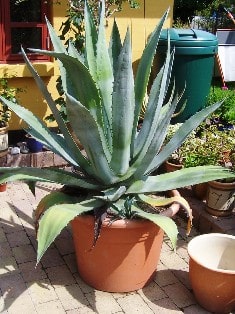
These are in-ground specimens and grow quite quickly producing many blossoms. One can easily identify them by their strong stems and large sizes making them beautiful grow succulents. They have smooth leaves carried in rosettes. The stem cutting method can be used to propagate and create new agave succulents.
2. Dasylirion
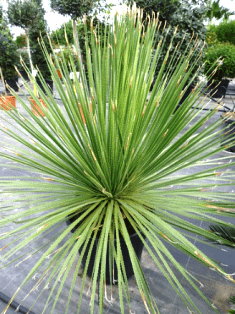
You may say that it looks exactly like a palm, but don’t get confused they are succulents only. Leaves have green, greyish, or blue-green and they are like a strap with small, sharp teeth that line the leaf edges. Their woody trunks make them appear even less like succulents. You need not water them regularly as they are the habitat of growing in desserts. You can easily propagate by leaves or even stem cutting method.
3. Dudleya
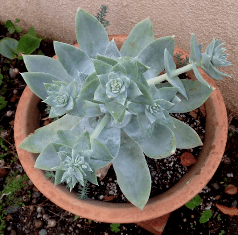
This lovely succulent has a lovely flower, rosette shape, and pattern. Their fleshy “petals” are present in green, red, purple, grey, or a mix of colors. They grow in completely opposite seasons as compared to Echeverias.
It is preferred to keep these dry during summers. You can either grow them in containers or even in rock gardens. Flowers emerge in shades of red, pink, yellow, and white colors. They attract hummingbirds.
4. Euphorbia
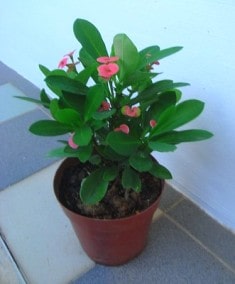
They are properly known as spurge. There are more than 1,000 species available in the euphorbia family. Some may develop the look of cactus, while others are globe-shaped. In mild climates, they can grow into shrubs.
You need to water them regularly, especially when found soil is dry. If you wish to propagate then either use the stem cutting method or leaves.
Step by Step process to grow your first succulent
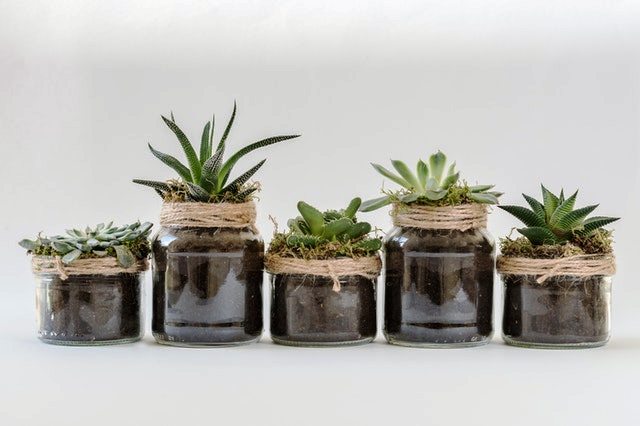
- Step 1: Choose a container that has drainage at the bottom. Anything that has a hole at the bottom and does not let water retained will prevent roots from rotting.
- Step 2: Choose an easy-to-grow succulent from the above list. Choose potting soil that is light and promotes aeration for the roots.
- Step 3: Planting the succulent in the container. Fill about one-fourth of the bottom of the container with the potting soil and then gently remove the succulent from the nursing container and put it in the new container. And then put potting soil again at the top. Make sure you keep the soil packed in the container.
- Step 4: Watering the succulent. Pour water slowly into the container. Watering the succulent may be required once a week or once in a few weeks according to the climate you live in.
- Step 5: Lights for the succulents. Succulent loves sunlight. Some succulents may get burned if kept outside in scorching hot. Special care should be taken if the temperature falls below 50 degrees Fahrenheit.
- Step 6: Add fertilizers to the succulent container. Different varieties of succulents require different fertilizers. Adding fertilizer once a month is okay.
- Step 7: Grooming the succulent plant. Once in a while, you will need to check the succulent plants if there are any bugs creeping or fungus growing on the plant. Remove any litter leaf in the container. Keep it clean and nice looking.
Choosing the Right Succulent
- Some succulents may require more water during the summer season. If you live in a region with very little rainfall, then you may water them regularly.
- During winters, it’s the opposite you need to water them less and give them more time to grow as they aren’t growing actively during this season.
- You should always start with easy-to-grow succulents.
So, these were some of the best succulents available out there. I hope, you liked our list and will start your gardening journey soon.
You may like:
- Best Succulent Identification Apps
- 11 Plant Care Apps to Keep Track of Your House Plants
- How to Get Rid of Bugs on Houseplants Home Remedies
- Best Vegetable Gardening Apps for 2020
- Best small indoor plant watering cans to buy
